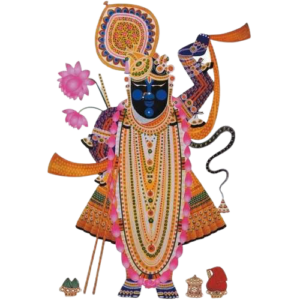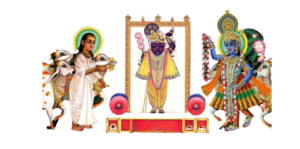The charming town of Nathdwara, located in the royal state of Rajasthan, India, is renowned for its deeply rooted devotion to Shreenathji, the beloved child deity of Lord Krishna. This enchanting place serves as the abode of Shreenathji, who is lovingly adored by millions of devotees. In this blog, we will explore the fascinating story of Shreenathji, the rituals, and customs associated with His worship, and the spiritual significance that has made Nathdwara a prominent pilgrimage destination.
The Legend of Shreenathji
The story of Shreenathji begins in the late 17th century when the idols of Lord Krishna, Radha, and her companions were being transported from Vrindavan to a safer location to protect them from the religious persecution during the reign of Mughal Emperor Aurangzeb. Fearing desecration, the devotees carrying the idols reached a place in the Aravalli Hills, around 48 kilometers from Udaipur, and decided to rest there temporarily.
Legend has it that the wheel of the chariot carrying the idols got stuck in the mud at this spot, which was believed to be the divine will. Taking it as a sign, they decided to establish a temple at that location, and thus, Nathdwara was born. The town’s name itself means “Gateway to the Lord,” and it is the gateway to devotion, love, and the enchanting deity Shreenathji.
Shreenathji – The Divine Child
Shreenathji is adored as a divine child. Unlike traditional depictions of Lord Krishna as an adult, Shreenathji is worshipped as a seven-year-old “laddu gopal” (infant Krishna) with a charming, endearing appearance. He is adorned with exquisite attire, jewelry, and a peacock feather crown, making Him the apple of devotees’ eyes. The image of Shreenathji exudes a captivating childlike innocence and mischief that resonates deeply with His devotees.
The daily life of Shreenathji revolves around His various “Darshans” or appearances throughout the day. These Darshans are a significant part of the rituals and customs at the temple, and each one represents a different facet of His life. The Mangala Darshan, Shringar Darshan, Rajbhog Darshan, and Shayan Darshan are some of the important moments when devotees gather to witness Shreenathji’s divine presence.

Rituals and Customs of Shreenathji Worship
The worship of Shreenathji is highly ritualistic, and every aspect of it is carried out with utmost devotion and precision. Here are some key rituals and customs associated with Shreenathji worship:
1. Rajbhog and Shringar: The Rajbhog is the grand midday meal offered to Shreenathji, while the Shringar involves adorning the deity with beautiful garments, jewelry, and flowers. The Shringar Darshan is a time when devotees can witness Shreenathji dressed in all His splendor.
2. Annakut: Annakut is a special offering where a mountain of various food items, often in the shape of a Govardhan Hill, is presented to Shreenathji. This tradition is celebrated with great enthusiasm during festivals like Govardhan Puja and Annakut Darshan.
3. Charan Seva: Devotees often have the opportunity to serve the Lord by performing the Charan Seva, where they gently wave a peacock feather fan (Chamara) over Shreenathji to keep Him cool and comfortable.
4. Jhulan Leela: During the swing festival (Jhulan Yatra), a beautifully decorated swing is prepared for Shreenathji, and devotees sing devotional songs as they swing the deity. This signifies the playful aspect of Lord Krishna’s life as a child.
5. Raag Kirtans: The devotional music, known as “Raag Kirtans,” is performed regularly in the temple. These hymns are sung in specific ragas (musical modes) and are considered highly spiritual.
6. Aarti: Traditional aarti ceremonies are conducted throughout the day, with the Mangala Aarti marking the commencement of the day, and the Shayan Aarti signifying the end. Devotees participate in these aarti rituals with utmost devotion.
The Spiritual Significance of Shreenathji
Shreenathji’s significance goes beyond being a mere idol; He is regarded as a living deity who reciprocates the love and devotion of His devotees. The intimate relationship that devotees share with Shreenathji is akin to that of a parent and child. The deity is considered a friend, confidant, and protector, and the bond of love between Shreenathji and His devotees is unbreakable.
The act of “seva” (service) to Shreenathji is considered an act of love and devotion. Devotees see themselves as caregivers of the divine child, and this sense of responsibility strengthens their connection with the deity.
Shreenathji’s presence is believed to bring prosperity, joy, and well-being to the lives of His devotees. His worship is not limited to a religious duty but is a way of life that fosters spiritual growth, selflessness, and deep love.
Nathdwara – A Pilgrimage Destination
Nathdwara has emerged as a prominent pilgrimage destination for followers of Shreenathji. The town, with its vibrant culture, narrow streets, and a unique blend of devotion and artistry, draws visitors from all around the world.
The renowned Nathdwara Temple, also known as Shreenathji Temple, is the epicenter of devotion in the town. Its stunning architecture, intricate artwork, and the aura of spirituality make it a must-visit destination for spiritual seekers and art enthusiasts alike.
The town is also famous for its Pichwai paintings and traditional handicrafts, which are closely associated with the worship of Shreenathji. These art forms depict scenes from Lord Krishna’s life and add to the rich cultural tapestry of Nathdwara.
Conclusion
Shreenathji, the living God child of Nathdwara, embodies the essence of devotion, love, and innocence. The temple town of Nathdwara, with its deep-rooted customs and rituals, is a place where divinity blends with everyday life. The love and devotion that devotees have for Shreenathji transcend the physical presence of the deity, and it is this relationship that forms the heart of the Nathdwara experience.
Visiting Nathdwara and witnessing the daily rituals and customs associated with Shreenathji is not just a pilgrimage; it’s a profound spiritual journey that leaves an indelible mark on one’s heart. The living God child of Nathdwara continues to enchant devotees with His divine grace and playful charm, drawing them into the eternal circle of love and devotion.

